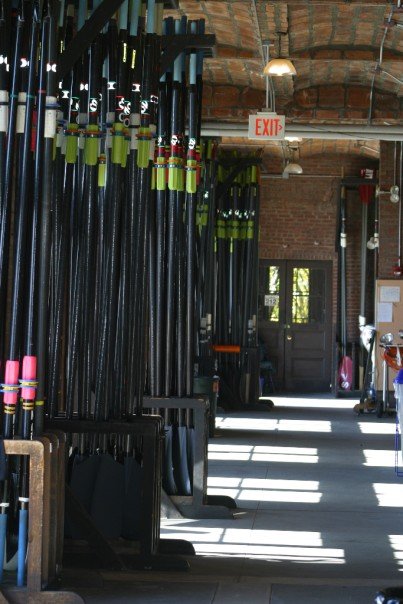| Billy Whitford, NAC leader extraordinaire! |
How do you keep motivated during long, boring, painful winter training?
Well...a lot of it is pretty tedious. At some point, erging just becomes erging, no matter how creative you are at breaking up the pieces or changing the stroke rating. I like to set goals for myself for the winter as a whole and also for each workout. It's extremely helpful to keep a notebook with your splits and heartrates for workouts that you do again and again. When it comes to steady state, your notebook can motivate you because you see how your heartrate gets a little better (over time) as you hold the same splits. And for pieces, you can ballpark how much faster would be moderate improvement, and how much faster would be an awesome piece!
 |
| Photo: stronglifts.com |
The other thing it's helpful to realize is that you can--and should!--work on technique on the erg. Erging in front of a mirror will allow you to check if you have a horizontal drive with a good sequence from catch to finish, and you can check if you're sitting up throughout the stroke and not picking up the work by opening your body. Nobody wants to be this guy!
Another great question:
Which is more effective in training...explosive/speed pieces or long ss [steady state] pieces? Also what is your diet? Do you take supplements?
Both of those types of training belong in everyone's workout regimen, regardless of your training volume and training goals. What you are trying to train for should determine the specifics of those workouts--for example, if your major training goal is winning the Head of the Charles, it would be less important to focus on 2K-specific speed workouts than on longer, 5K-specific workouts. Since physiologically a 2K is akin to doing as many power high pulls as you can, at the highest weight you can manage, in 5 to 8 minutes, training should help you build rowing-related muscle strength and then aerobically and anaerobically condition that muscle strength.
Most people will see benefits across the board from doing more steady state work. Aerobic fitness helps you build the system that delivers oxygen to your muscles, and is a big part of the middle 1500 meters of a 2K race. But anaerobic work--including longer, hard pieces and interval training--is needed so that you can push your body to its limit, break it down, and allow it to build back stronger and fitter than it was before. Every team I've ever been on does 2-3 "hard" practices each week, with the rest of the training time spent on steady state, cross-training, and lifting--a ratio that seems to work well. I have definitely benefited from both types!
My diet isn't anything too special. About 95% of the time, I treat food like fuel. If it isn't going to help me perform better on the water or the erg, it's not worth eating. There's always room for fruits and vegetables, nuts, Greek yogurt, muesli, whole-grain pasta and quinoa, and lean meats--and a LOT of water, milk, and other hydration sources. I also use hydration and recovery drinks from Shaklee and nuun. The other 5%...well, we train a lot, and one of the luxuries of that is getting to have things like an ice cream or a beer once in a while. But staying on top of what you're using to fuel your body is a huge performance enhancer.
 |
| Photo: sportsmd.com. |
Taking supplements is very risky, because there are so many ones on the market that are unregulated and could contain things entirely different than what the label reads (and for our team and NCAA athletes, banned substances). I do take a few supplements--a multivitamin, fish oil, iron--very basic things. I only use companies that are specifically focused on quality (all of these companies market their products to athletes who are drug tested) and that have extreme quality control on their products. Right now, I rely on Shaklee products, which are extremely high in quality, developed with athletes in mind, and cover a range of needs from multivitamin to sports recovery to highly-specialized supplementation.
 |
| Photo: solgar.com |
A lot of the questions readers posted were training-specific, and while I'm not going to post my training journal on here, there are a lot of really good resources online that can help answer your questions! I would suggest always talking with your coach about what you want to work on, because your coach will likely have additional workouts (or stretches, or rest!) that they would prefer you do.
High Performance Rowing - well-researched journal/performance articles relevant to rowers.
Eat to Win and Paleo Diet for Athletes - these two books are helpful for understanding how to treat food as fuel. Just be sure to take both "plans" with a grain of salt, and be sure to meet with a nutritionist before starting any major shift in your diet.
Role Model Rowing and Drew Ginn's Youtube- Besides looking on YouTube, Carlos Dinares has a great collection of "good rowing" videos, both sweep and sculling, on his website. I also like to check out Drew Ginn's YouTube channel for videos of good sweep rowing.
Hopefully this provides some helpful answers--I'll try to respond to more of the questions next week! And, as always, feel free to leave comments or more questions here! Thanks and GO USA! -Esther















No comments:
Post a Comment